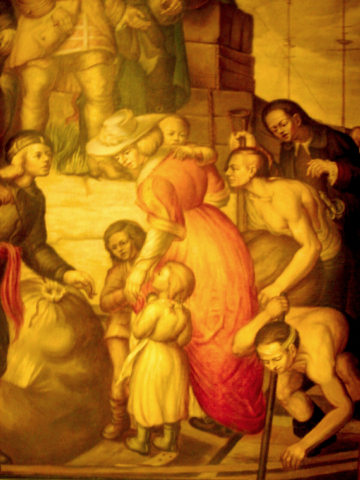
inset from Immigration: Landing of the Swedes by Albert Pels
ART IN FEDERAL BUILDINGS
By Peter T. Dalleo, Clerk of Court, 2002
As early as 1855, Congress had provided for art in some federal buildings. That year Congress commissioned Constantino Brumidi to paint frescos in the committee rooms of the U.S. House of Representatives in Washington, D.C.1. The decision to place a new multi-agency building in Wilmington, Delaware in the 1930s is an example of a more recent opportunity to showcase American artists.
Usually the Federal Art Program assumed responsibility for decorating national postal facilities, but in the case of the Rodney Square Post Office, Court House and Custom House, the Treasury Department’s art section did. Wilmington’s Associated Federal Architects, a combine of local architectural firms, formed a committee to receive and judge sketches for paintings that portrayed the city’s history. Committee members included Christopher L. Ward, E. William Martin, and George Harding, a Philadelphia mural painter. During March and April 1937, they met in the Wilmington Free Institute Library, the Beaux Arts building that bordered one side of the square, and selected the winners of the national competition.
In June, the Treasury Department announced the two winners - Albert Pels and Herman H. Zimmerman. Pels chose as his theme “Immigration” to emphasize the Wilmington’s early links with Europe and planned to hang the work behind the district court bench in the second-floor courtroom. Zimmerman’s murals, “Chemistry and Industry” and “Chemistry and Agriculture” decorated the lobby of the Post Office and emphasized the prominence of Wilmington’s chemical industry. They were not completed until April 1938 after the building had opened2.
The Honorable John P. Nields, the district judge who used the courtroom, noted that the Pels mural “has all the qualities of a very fine tapestry.” Pels, like Zimmerman, was Cincinnati born and, in his case, trained at the Cincinnati Arts Academy. The artist had studied and worked in Europe and New York. The mural’s subject was the landing of the Swedes in 1638 at The Rocks in the Christiana River that represents women, children, artisans, clergymen, and soldiers as participants. Pels chose Peter Minuit, the leader of both the first Swedish expedition to Delaware and the first Dutch expedition to New York, as the mural’s central figure3. His decision to depict only white immigrants is probably historically correct, because the first known African American who came with the Swedes, Black Anthony, did not arrive until 16394. Pels later created artwork for federal facilities in Washington, D.C. and Normal, Illinois.
The building remained in government hands until 1973 when most federal offices moved to the J.Caleb Boggs Courthouse on King Street. Wilmington Trust assumed ownership of the Rodney Square property and set up its headquarters where the two Zimmerman murals remain a prominent part of the lobby. The Pels mural, however, was relocated with the postoffice branch to the King Street side of the building where it can be viewed today in the main public service area.
- "Art in Architecture," Focus, Summer 2002, p. 6.
- Majorie McNinch, "The Changing Face on Rodney Square," Delaware History, 21 (1995): 162-163.
- Every Evening, April 8, 1838 and June 7, 1837.
- William H. Williams, Freedom in the First State, pp. 2-3
